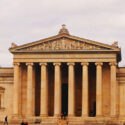Just before the bridge to the Old Town in Stockholm, there is a well-hidden gem for lovers of antiquity museum lovers. On a side street there, the Mediterranean museum throws a wide net to present several cultures around and in the Mediterranean Sea. The building is housed in an old bank building, and this becomes all the more apparent inside where the entrance to the Egyptian section has a wide bank vault door standing open. You cannot help but hesitate before entering but in this museum, you are welcomed by remains from Egypt, Cyprus, Rome with its once swelling controlled regions in Europe, and Greece. Upon entering the largest room with the high ceiling, I quickly find the relatively small side wing where Roman antiquities have been placed, or should I say tucked away. The design of the museum is interesting, seeing as the focal points for the visitor draw the attention to places and timespans one might not expect.
A slightly different focus in the Mediterranean region
Egypt, Cyprus throughout time, and finally Greece and Rome. These are spread out in the atrium and the side rooms in the buildings. Greece and Rome have their places in this museum as well, but the Cyprus and Egypt exhibitions are considerably more prominent. Etruscans are mentioned in some signs that tell the story of the Roman Empire. A glance at the history of previous exhibitions shows that this museum fancies constant renewal with exhibitions with odd and exciting topics.
This is is an exciting layout, and you are led to connect dots in time and place that you possibly would not do otherwise, especially so if you are happy to explore the history with little preconceptions about how a museum for ancient cultures should look or what the scope should be.
Cypriotic trade and gateway in the eastern Mediterranean
So then what do the objects from Cyprus tell us of ancient times? One thing is clear, Cyprus was teeming with trade activity. It functioned as a gateway to the eastern Mediterranean. There are examples of Coptic writing in this museum, on the banks of the shores of the Scandinavian former Hanseatic city. The Roman part of the exhibition is considerably smaller than the entirety of the museum’s artifacts. The Egyptian and Cypriot parts have more prominent positions in the museum, and this is particularly clear seeing as how the Cypriotic exhibits are placed in the center of the atrium.
A bite to eat with a view of ancient art
On the top floor, there is a surprise, that is where Bagdad Café is and where Swedes and tourists alike enjoy a bite to eat and drink. In the aisle on the second floor, you can sit surrounded by ancient ceramics. Even if you cannot get a table there, the view of the entire atrium is magnificent adds to the atmosphere, and is a peaceful way to conclude a visit to the museum.





